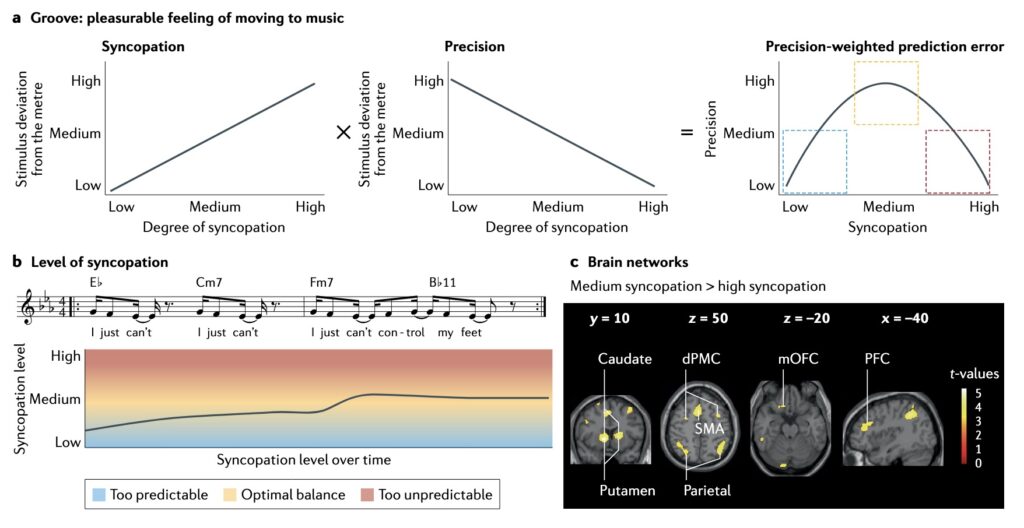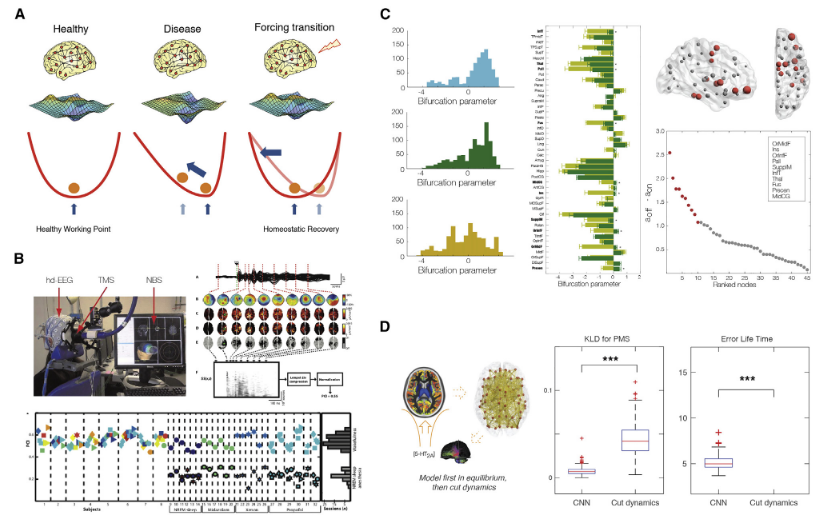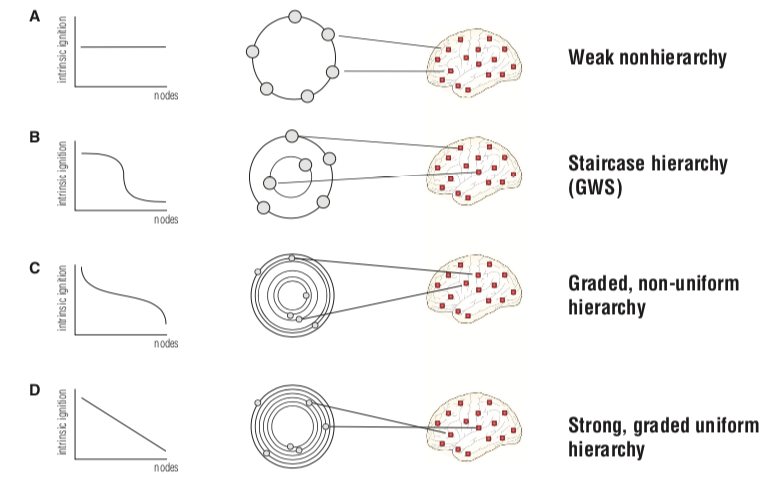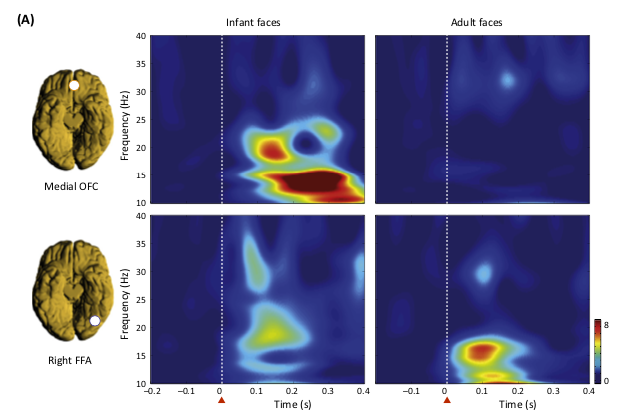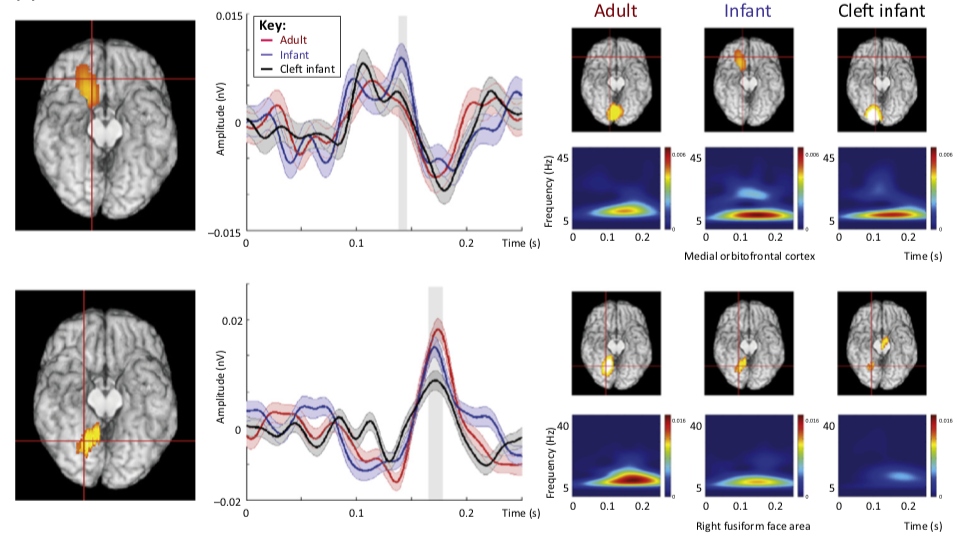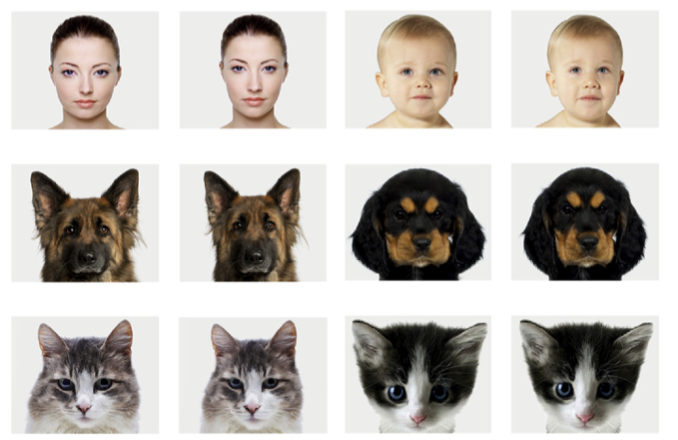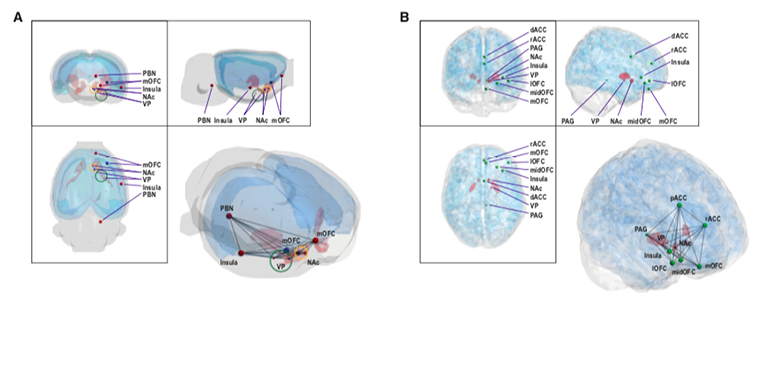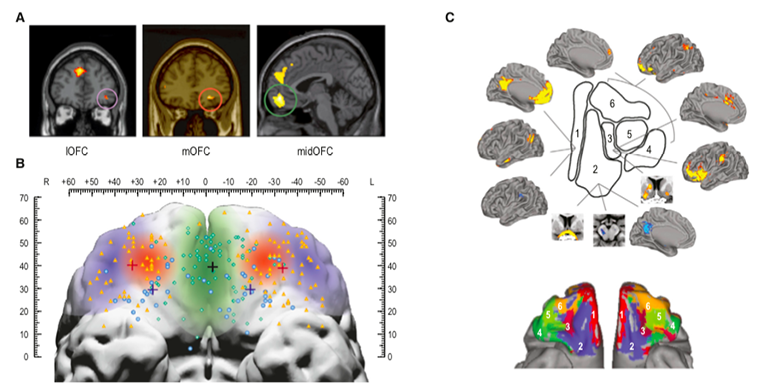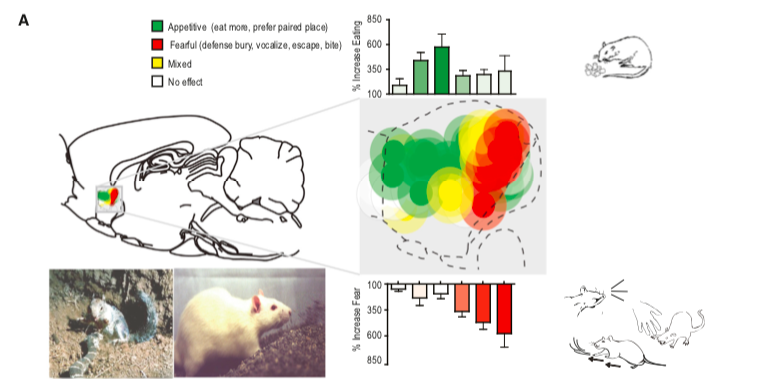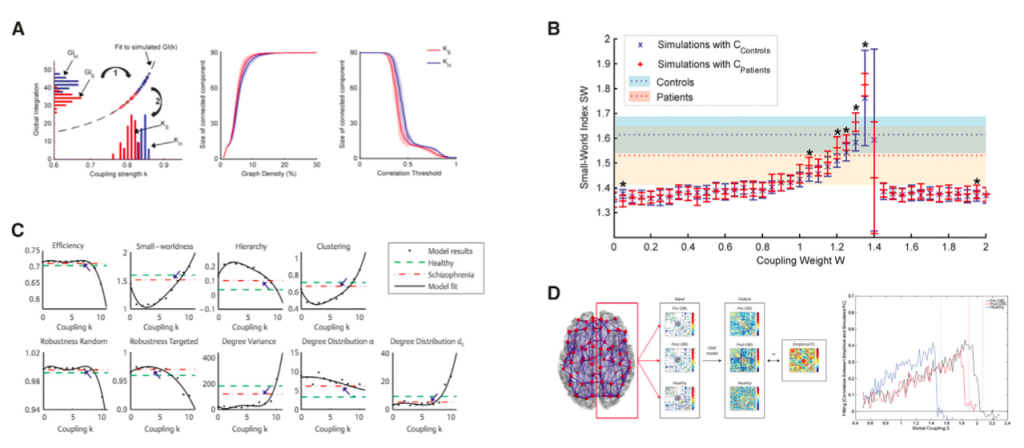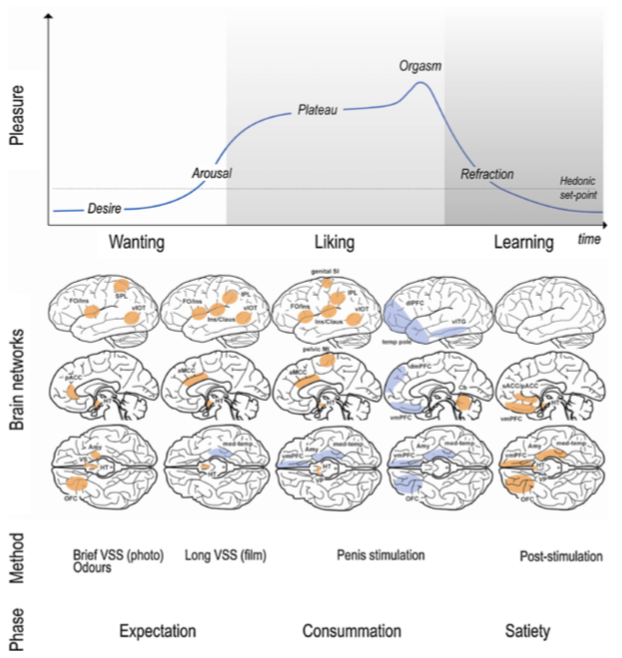Top 10 REVIEWS
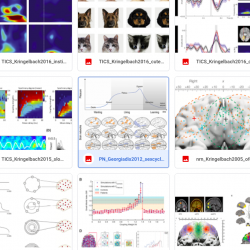
Top10 Reviews

Thermodynamics of Mind
| Kringelbach M.L., Sanz Perl Y. & Deco G. (2024) Thermodynamics of Mind. Trends in Cognitive Science, 28(6):568-581 |
Abstract: In order not only to survive but also to thrive, the brain must efficiently orchestrate distributed computation across space and time. This requires hierarchical organisation facilitating fast information transfer and processing at the lowest possible metabolic cost. Quantifying brain hierarchy is difficult but can estimated from the asymmetry of information flow. Thermodynamics has successfully characterised hierarchy in many other complex systems. Here, we propose the ‘Thermodynamics of Mind’ framework as a natural way to quantify hierarchical brain orchestration and its underlying mechanisms. This has already provided novel insights into the orchestration of hierarchy in brain states including movie-watching, where the brain’s hierarchy is flatter than during rest. Overall, this framework holds great promise for revealing the orchestration of cognition.
Music in the brain
| Vuust P., Heggli O., Friston K. & Kringelbach M.L. (2022) Music in the brain, Nature Reviews Neuroscience 23: 287-305. |
Abstract: Music is ubiquitous across human cultures — as a source of affective and pleasurable experience, moving us both physically and emotionally — and learning to play music shapes both brain structure and brain function. Music processing in the brain — namely, the perception of
melody, harmony and rhythm — has traditionally been studied as an auditory phenomenon using passive listening paradigms. However, when listening to music, we actively generate predictions about what is likely to happen next. This enactive aspect has led to a more comprehensive
understanding of music processing involving brain structures implicated in action, emotion and learning. Here we review the cognitive neuroscience literature of music perception. We show that music perception, action, emotion and learning all rest on the human brain’s fundamental capacity
for prediction — as formulated by the predictive coding of music model. This Review elucidates how this formulation of music perception and expertise in individuals can be extended to account for the dynamics and underlying brain mechanisms of collective music making. This in turn has
important implications for human creativity as evinced by music improvisation. These recent advances shed new light on what makes music meaningful from a neuroscientific perspective.
Brain States and Transitions
|
|
Kringelbach ML & Deco G (2020) Brain States and Transitions: Insights from Computational Neuroscience. Cell Reports, 32(10):108128. |
Abstract:
Within the field of computational neuroscience there are great expectations of finding new ways to rebalance the complex dynamic system of the human brain through controlled pharmacological or electromagnetic perturbation. Yet many obstacles remain between the ability to accurately predict how and where best to perturb to force a transition from one brain state to another. The foremost challenge is a commonly agreed definition of a given brain state. Recent progress in computational neuroscience has made it possible to robustly define brain states and force transitions between them. Here, we review the state of the art and propose a framework for determining the functional hierarchical organization describing any given brain state. We describe the latest advances in creating sophisticated whole-brain computational models with interacting neuronal and neurotransmitter systems that can be studied fully in silico to predict and design novel pharmacological and electromagnetic interventions to rebalance them in disease.
Hierarchy of information processing
|
|
Deco G. & Kringelbach ML (2017) Hierarchy of information processing in the brain: a novel ‘intrinsic ignition’ framework. Neuron, 94: 961-8. |
Abstract: A general theory of brain function has to be able to explain local and non-local network computations over space and time. We propose a new framework to capture the key principles of how local activity influences global computation, i.e., describing the propagation of information and thus the broadness of communication driven by local activity. More specifically, we consider the diversity in space (nodes or brain regions) over time using the concept of intrinsic ignition, which are naturally occurring intrinsic perturbations reflecting the capability of a given brain area to propagate neuronal activity to other regions in a given brain state. Characterizing the profile of intrinsic ignition for a given brain state provides insight into the precise nature of hierarchical information processing. Combining this data-driven method with a causal whole-brain computational model can provide novel insights into the imbalance of brain states found in neuropsychiatric disorders.
Cuteness
|
|
Kringelbach ML, Stark E.A., Alexander C., Bornstein M.H. & Stein A. (2016) On cuteness: Unlocking the parental brain and beyond. Trends in Cognitive Sciences, 20(7): 545-58. |
Abstract: Cuteness in offspring is a potent protective mechanism that ensures survival for otherwise completely dependent infants. Previous research has linked cuteness to early ethological ideas of a ‘Kindchenschema’ (infant schema) where infant facial features serve as ‘innate releasing mechanisms’ for instinctual caregiving behaviours. We propose extending the concept of cuteness beyond visual features to include positive infant sounds and smells. Evidence from behavioural and neuroimaging studies links this extended concept of cuteness to simple ‘instinctual’ behaviours and to caregiving, protection, and complex emotions. We review how cuteness supports key parental capacities by igniting fast privileged neural activity followed by slower processing in large brain networks also involved in play, empathy, and perhaps even higher-order moral emotions.
Pleasure systems in the brain
|
|
Berridge K.C. & Kringelbach ML (2015) Pleasure systems in the brain. Neuron 86:646-664. |
Abstract: Pleasure is mediated by well-developed mesocorticolimbic circuitry and serves adaptive functions. In affective disorders, anhedonia (lack of pleasure) or dysphoria (negative affect) can result from breakdowns of that hedonic system. Human neuroimaging studies indicate that surprisingly similar circuitry is activated by quite diverse pleasures, suggesting a common neural currency shared by all. Wanting for reward is generated by a large and distributed brain system. Liking, or pleasure itself, is generated by a smaller set of hedonic hot spots within limbic circuitry. Those hot spots also can be embedded in broader anatomical patterns of valence organization, such as in a keyboard pattern of nucleus accumbens generators for desire versus dread. In contrast, some of the best known textbook candidates for pleasure generators, including classic pleasure electrodes and the mesolimbic dopamine system, may not generate pleasure after all. These emerging insights into brain pleasure mechanisms may eventually facilitate better treatments for affective disorders.
Great expectations
|
|
Deco G. & Kringelbach ML (2014) Great expectations: using whole-brain computational connectomics for understanding neuropsychiatric disorders. Neuron, 84(3): 892-905. |
Abstract: The study of human brain networks with in vivo neuroimaging has given rise to the field of connectomics, furthered by advances in network science and graph theory informing our understanding of the topology and function of the healthy brain. Here our focus is on the disruption in neuropsychiatric disorders (pathoconnectomics) and how whole-brain computational models can help generate and predict the dynamical interactions and consequences of brain networks over many timescales. We review methods and emerging results that exhibit remarkable accuracy in mapping and predicting both spontaneous and task-based healthy network dynamics. This raises great expectations that whole-brain modeling and computational connectomics may provide an entry point for understanding brain disorders at a causal mechanistic level, and that computational neuropsychiatry can ultimately be leveraged to provide novel, more effective therapeutic interventions, e.g., through drug discovery and new targets for deep brain stimulation.
The human sexual response cycle
|
|
Georgiadis J. & Kringelbach ML (2012) The human sexual response cycle: brain imaging evidence linking sex to other pleasures. Progress in Neurobiology, 98(1): 49-81. |
Abstract: Sexual behavior is critical to species survival, yet comparatively little is known about the neural mechanisms in the human brain. Here we systematically review the existing human brain imaging literature on sexual behavior and show that the functional neuroanatomy of sexual behavior is comparable to that involved in processing other rewarding stimuli. Sexual behavior clearly follows the established principles and phases for wanting, liking and satiety involved in the pleasure cycle of other rewards. The studies have uncovered the brain networks involved in sexual wanting or motivation/anticipation, as well as sexual liking or arousal/consummation, while there is very little data on sexual satiety or post-orgasmic refractory period. Human sexual behavior also interacts with other pleasures, most notably social interaction and high arousal states. We discuss the changes in the underlying brain networks supporting sexual behavior in the context of the pleasure cycle, the changes to this cycle over the individual’s life-time and the interactions between them. Overall, it is clear from the data that the functional neuroanatomy of sex is very similar to that of other pleasures and that it is unlikely that there is anything special about the brain mechanisms and networks underlying sex.
Translational principles of deep brain stimulation
| Kringelbach ML, Jenkinson N., Owen S.L.F. & Aziz T.Z. (2007) Translational principles of deep brain stimulation. Nature Reviews Neuroscience, 8:623-635. |
Abstract: Deep brain stimulation (DBS) has shown remarkable therapeutic benefits for patients with otherwise treatment-resistant movement and affective disorders. This technique is not only clinically useful, but it can also provide new insights into fundamental brain functions through direct manipulation of both local and distributed brain networks in many different species. In particular, DBS can be used in conjunction with non-invasive neuroimaging methods such as magnetoencephalography to map the fundamental mechanisms of normal and abnormal oscillatory synchronization that underlie human brain function. The precise mechanisms of action for DBS remain uncertain, but here we give an up-to-date overview of the principles of DBS, its neural mechanisms and its potential future applications.
The human orbitofrontal cortex
|
|
Kringelbach ML (2005) The human orbitofrontal cortex: linking reward to hedonic experience. Nature Reviews Neuroscience, 6:691-702. |
Abstract: Hedonic experience is arguably at the heart of what makes us human. In recent neuroimaging studies of the cortical networks that mediate hedonic experience in the human brain, the orbitofrontal cortex has emerged as the strongest candidate for linking food and other types of reward to hedonic experience. The orbitofrontal cortex is among the least understood regions of the human brain, but has been proposed to be involved in sensory integration, in representing the affective value of reinforcers, and in decision making and expectation. Here, the functional neuroanatomy of the human orbitofrontal cortex is described and a new integrated model of its functions proposed, including a possible role in the mediation of hedonic experience.

